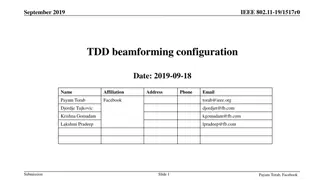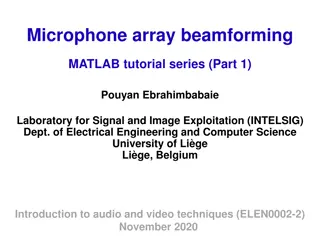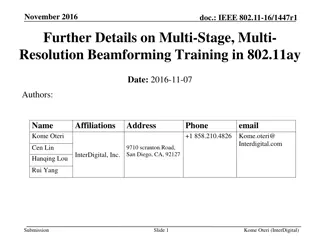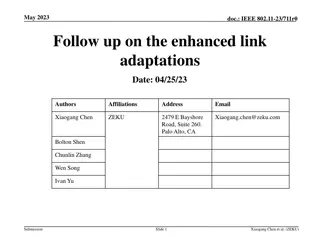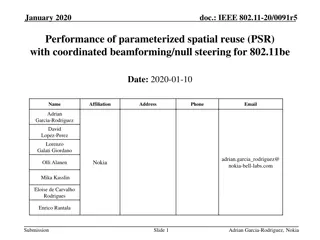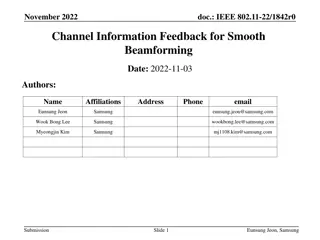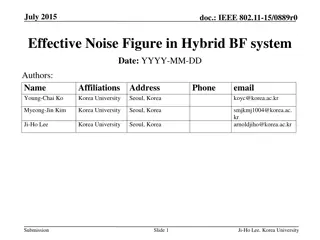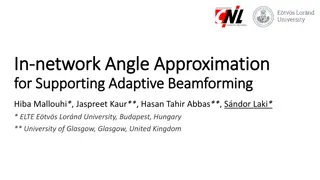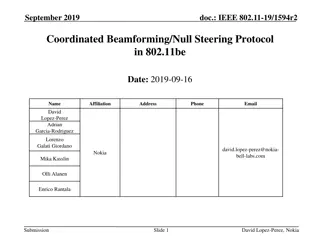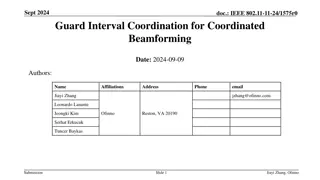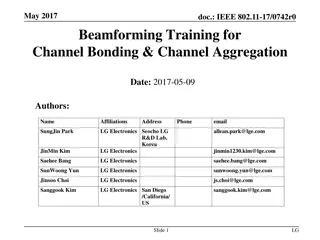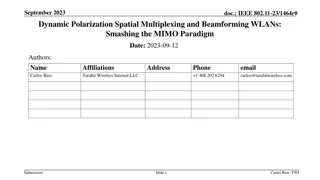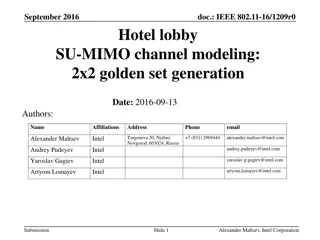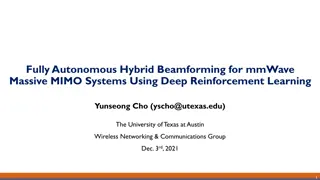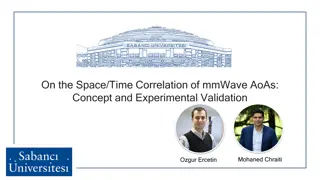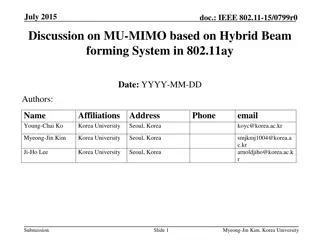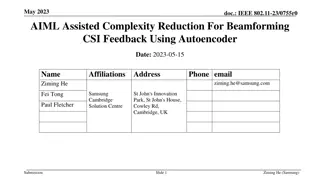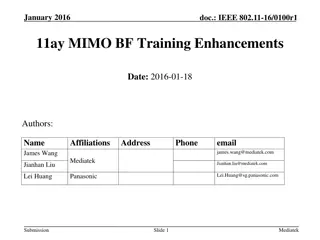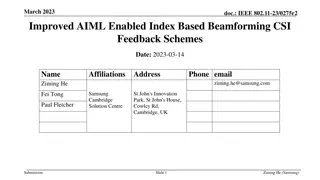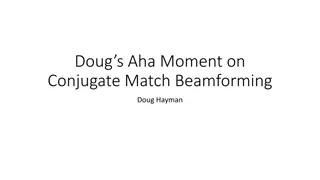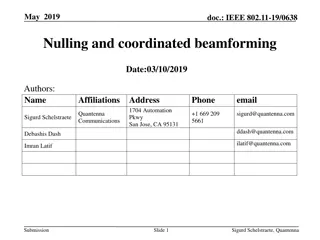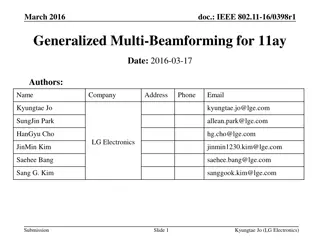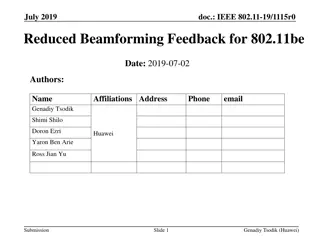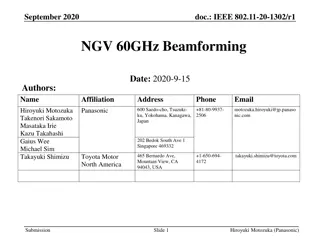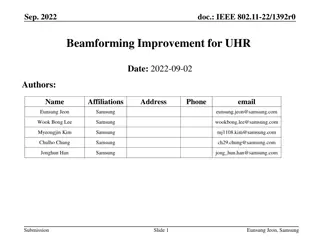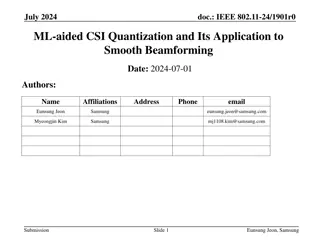Channel Information Feedback Enhancement for Improved Beamforming Performance
Beamforming plays a crucial role in achieving high throughput in wireless networks, but issues with discontinuity in beamforming lead to performance limitations. This document discusses the challenges with current beamforming practices and proposes a solution by increasing feedback overhead to enhan
2 views • 17 slides
IEEE 802.11-19/1517r0 TDD Beamforming Configuration Overview
IEEE 802.11-19/1517r0 discusses TDD beamforming operations related to Beam Measurement in the standard. Before Draft 4.0, these operations were primarily initiated by SME, causing limitations due to proprietary network controllers. The document reviews gaps and improvements in TDD beamforming, aimin
2 views • 10 slides
Introduction to Microphone Array Beamforming: MATLAB Tutorial Series
Explore microphone array beamforming techniques in this MATLAB tutorial series by Pouyan Ebrahimbabaie from the Laboratory for Signal and Image Exploitation at the University of Liège, Belgium. Learn about acoustic array geometry, signal processing, time-delay beamforming, and more to enhance audio
0 views • 27 slides
Enhancements in Multi-Stage Beamforming Training for IEEE 802.11ay
IEEE 802.11ay introduces improvements in beamforming training procedures for efficiency and MIMO support. The multi-stage, multi-resolution beamforming training framework enhances beamforming efficiency with high-resolution beams. The proposal includes a Sector Sweep frame and support for up to 2048
0 views • 19 slides
Multi-Stage, Multi-Resolution Beamforming Training for IEEE 802.11ay
In September 2016, a proposal was introduced to enhance the beamforming training procedures in IEEE 802.11ay for increased efficiency and MIMO support. The proposal suggests a multi-stage, multi-resolution beamforming training framework to improve efficiency in scenarios with high-resolution beams a
1 views • 11 slides
IEEE 802.11-23/711r0 May 2023 Document Summary: Enhanced Link Adaptation Discussions
The May 2023 document IEEE 802.11-23/711r0 discusses topics like beamforming feedback, closed-loop rate adaptations, and issues related to beamforming feedback in a wireless communication context. It elaborates on the challenges of feedback optimization and post-SNR degradation, suggesting solutions
0 views • 15 slides
Performance Evaluation of Parameterized Spatial Reuse with Coordinated Beamforming for IEEE 802.11be
The study focuses on assessing the performance of parameterized spatial reuse (PSR) with coordinated beamforming/null steering for IEEE 802.11be. The framework allows coordinated sharing of uplink transmission opportunities among APs, demonstrating gains in synchronous coordinated beamforming system
1 views • 19 slides
Channel Information Feedback for Beamforming Enhancement
Beamforming is essential for achieving high throughput in wireless communication, but it still requires improvements, especially when combined with channel smoothing techniques. This document discusses the challenges of discontinuities in beam-steering matrices and proposes a feedback mechanism for
1 views • 13 slides
Smooth Beamforming with Feedback Overhead Reduction in IEEE 802.11-23
This document discusses a method for reducing feedback overhead in smooth beamforming to optimize phase rotations for V matrix in IEEE 802.11-23 standard. It explores V matrix optimization, column-wise phase shift, and beamformer side optimization to achieve channel smoothing gain at the receiver si
1 views • 14 slides
Noise Figure Analysis in Hybrid Beamforming Systems
This document discusses the theoretical study of noise figure (NF) and gain in hybrid beamforming systems, focusing on the impact of additional RF blocks, such as phase shifters and combiners, on noise figure calculations. It explains how the received signals from multiple antennas are phase-correct
0 views • 11 slides
Beamforming in mmWave Transmission for 5G Networks
Adaptive beamforming plays a vital role in supporting mmWave transmission in 5G networks, addressing challenges like high propagation loss and signal blockage. The use of an innovative user-assisted approach, involving angle computation and configuration messages, enhances the beamforming process fo
0 views • 18 slides
Coordinated Beamforming/Null Steering Protocol in 802.11be
This document discusses the coordinated beamforming/null steering protocol in IEEE 802.11be, highlighting the challenges and benefits of joint transmission/reception. The protocol aims to efficiently realize gains in coordinated beamforming/null steering, presenting a viable solution for AP coordina
0 views • 15 slides
Channel Information Feedback for Smooth Beamforming
Beamforming is crucial for achieving high throughput in wireless networks, but existing methods face challenges due to discontinuity issues. This document proposes a solution to enhance channel smoothing gain and improve throughput by optimizing feedback mechanisms. It explores the impact of additio
3 views • 17 slides
Guard Interval Coordination for Coordinated Beamforming
This document discusses guard interval coordination for coordinated beamforming in IEEE 802.11 networks. It explores methods of coordination for effective beamforming strategies and transmission synchronization in multi-AP environments.
0 views • 9 slides
Beamforming Training for Channel Bonding & Channel Aggregation
This document discusses the beamforming training process for channel bonding and channel aggregation in IEEE 802.11 standards. It covers the different scenarios where beam refinement is required and proposes PPDU formats for training beamforming. The document outlines the procedures for refining the
0 views • 9 slides
Dynamic Polarization Spatial Multiplexing and Beamforming in WLANs
Breakthrough modulated polarization MIMO processing introduces Dynamic Polarization Spatial Multiplexing and Beamforming WLAN technology, capable of achieving high data rates over long distances. This revolutionary approach combines SMX and beamforming to enable up to 92 Gbps Fixed Wireless Access b
0 views • 17 slides
Channel Model Golden Set Generation for IEEE 802.11ay SU-MIMO Systems
This document discusses the generation of a golden set of channel impulse responses (CIRs) for IEEE 802.11ay 2x2 SU-MIMO scenarios. The focus is on the channel representation as a clustered propagation rays set and the generation of ready-to-use CIRs without the need for extensive channel generation
0 views • 12 slides
Autonomous Hybrid Beamforming for mmWave Massive MIMO Systems
Explore the use of deep reinforcement learning for fully autonomous hybrid beamforming in mmWave massive MIMO systems, addressing non-convexity and non-linearity challenges. The approach involves interaction between agents and environments to update neural network parameters, optimizing system perfo
0 views • 7 slides
Hybrid Beamforming Protocols in IEEE 802.11ay Standard
Explore the implementation and benefits of hybrid beamforming in IEEE 802.11ay for SU and MU-MIMO scenarios. The protocols presented demonstrate the performance advantages over analog beamforming, highlighting the use of combined baseband and analog techniques. Various beamforming methods are compar
0 views • 14 slides
Space-Time Correlation of mmWave AoAs: Concept & Experimental Validation
Explore the concept and experimental validation of space-time correlation of mmWave Angle of Arrivals (AoAs). The study delves into coherence time, channel equalization, and beamforming implications in free-space transmissions. Sparse vs. rich scattering scenarios are examined, along with conjunctur
0 views • 10 slides
Discussion on MU-MIMO Hybrid Beamforming System in 802.11ay
Explore the need for MU-MIMO in 802.11ay and parameters for supporting it, with a focus on hybrid beamforming and codebooks. Delve into the design challenges and considerations for efficient beamforming in MU-MIMO systems.
0 views • 11 slides
Complexity Reduction in Beamforming CSI Feedback Using Autoencoder
Explore how autoencoder-based schemes can reduce complexity in beamforming CSI feedback, comparing legacy and existing AIML beamforming schemes. Learn about the proposed autoencoder-based scheme's advantages and considered system parameters for performance evaluations in IEEE 802.11-23/0755r0 docume
0 views • 12 slides
Feedback of Channel State Information for Hybrid Beamforming in 802.11ay
This document discusses the feedback of channel state information (CSI) for enabling hybrid beamforming in the context of IEEE 802.11ay. It covers the challenges in estimating the effective channel matrix, the roles of RF and digital beamformings, and contributions towards obtaining CSI in hybrid be
1 views • 10 slides
Enhancements in MIMO BF Training for IEEE 802.11ay Standard
Explore the advancements in Multiple Input Multiple Output (MIMO) Beamforming (BF) training for the IEEE 802.11ay standard documented in January 2016. This document delves into analog and digital processing techniques, hybrid beamforming, multiple antenna operations, and typical beamforming training
0 views • 14 slides
Improved AIML Enabled Index Based Beamforming CSI Feedback Schemes
Explore the innovative AIML-enabled index-based beamforming schemes discussed in the March 2023 document IEEE 802.11-23/0275r2. This document presents insights into legacy beamforming schemes, AIML scenarios, and proposed schemes for both training and beamforming phases, enhancing communication effi
0 views • 20 slides
Understanding Phasors and Beamforming in Signal Processing
Explore the concepts of phasors, beamforming, and signal processing through a series of informative images and explanations. Learn about conjugate match beamforming, maximizing responses to desired signals, phase relationships, and more, all illustrated with helpful visuals and detailed insights.
0 views • 12 slides
Understanding Coordinated Beamforming in IEEE 802.11 Networks
Explore the concept of coordinated beamforming in IEEE 802.11 networks, focusing on nulling techniques to mitigate interference between access points. Learn how digital beamforming is used, the challenges in creating broad nulls, and the implications on signal reception. Verification steps and wavef
0 views • 11 slides
Understanding Coordinated Beamforming in IEEE 802.11 Networks
Explore the concept of coordinated beamforming as introduced in IEEE 802.11-19/0445 documents. Learn about nulling and coordinated beamforming techniques, their applications, challenges, and the impact on network performance. Gain insights into the process of nulling with digital beamforming and the
0 views • 11 slides
Generalized Multi-Beamforming Protocol for 11ay Wireless Networks
Explore the innovative approach of Generalized Multi-Beamforming for 11ay wireless networks, enhancing efficiency through simultaneous beam refinement for multiple stations and channels using dual-polarization. The proposed protocol facilitates Multi-BF capability exchange and beam refinement proced
0 views • 9 slides
IEEE 802.11-16/1484r1 Multi-Beamforming Procedure for 11ay
Explore the multi-beamforming protocol for 11ay, focusing on polarization antennas and dual-polarization capabilities. Learn about the exchange of multi-beamforming information between initiators and responders using dual-polarized antennas. Dive into the detailed process of multi-beamforming with p
0 views • 10 slides
Enhancing Beamforming for Next-Generation Wireless Communication
Explore the challenges and innovations in beamforming for IEEE 802.11be standard, focusing on increased spatial streams and MU-MIMO groups. Addressing the impact of larger precoding matrices while maintaining backward compatibility, the study delves into optimizing existing beamforming schemes for i
0 views • 14 slides
UL Beamforming Protocol Design for IEEE 802.11-24
Explore the protocol design for UL beamforming in IEEE 802.11-24 standard, addressing issues with TB PPDU transmission, throughput enhancement, and SNR improvements using beamforming technology. Detailed insights into sounding and channel information feedback protocols are provided for UL beamformin
1 views • 18 slides
UL Beamforming Protocol Design for IEEE 802.11-24
Enhance Rate-vs-Range (RvR) for UHR by introducing UL beamforming technology in trigger-based PPDU transmission. This contribution presents a high-level design of sounding and channel information feedback protocols for UL beamforming in UHR TB PPDU.
1 views • 18 slides
Performance of Parameterized Spatial Reuse with Coordinated Beamforming for IEEE 802.11be
Explore the evaluation of a spatial reuse parameter scheme with coordinated beamforming for IEEE 802.11be, leveraging the PSR framework for coordinated null steering. Learn about practical operation, key implementation benefits, and the performance gains of synchronous coordinated beamforming system
1 views • 19 slides
Advanced Beamforming Techniques for 60GHz Communication
Explore the latest advancements in beamforming technology for 60GHz communication, enabling extended communication ranges and improved performance in V2X scenarios. Discover innovative procedures and gain insights into beamforming protocols and implementation. Stay ahead in the realm of high-frequen
0 views • 11 slides
IEEE 802.11-18/0849r2 MU Exclusive Beamforming Report May 2018
Explore the detailed May 2018 report on MU Exclusive Beamforming in IEEE 802.11-18/0849r2, focusing on enhancing MU-MIMO performance through beamforming algorithms and channel selectivity analysis in 11ay compared to 11ac. Discover insights on per-tone SNR calculation, differential concepts, and pro
4 views • 10 slides
Understanding Residual Interference in Coordinated Beamforming for Wireless Networks
Explore the impact of residual interference in coordinated beamforming for IEEE 802.11 networks, evaluating enhancements like beamforming extension and channel estimation. Discover how non-aligned transmissions reduce overhead and simplify implementation, leading to improved throughput and reduced q
0 views • 9 slides
Beamforming Protocol Proposal for TDD Channel Access
Explore a beamforming protocol proposal for TDD channel access in mmWave distribution networks, addressing the limitations of existing paradigms. The presentation outlines asynchronous and synchronous beamforming approaches, frame formats, and key assumptions for effective implementation.
0 views • 26 slides
Improving Beamforming for Ultra High Reliability (UHR) in IEEE 802.11-22
Enhance your understanding of beamforming improvements for Ultra High Reliability (UHR) in the IEEE 802.11-22 standard. Explore the challenges, solutions, and potential advancements in smooth and UL beamforming techniques, aiming to increase WLAN connectivity reliability, reduce latencies, and boost
0 views • 9 slides
Smooth Beamforming Techniques for Improved Wireless Communication
Explore ML-aided CSI quantization techniques in IEEE 802.11-24/1901r0 standard for smooth beamforming. Learn about feedback schemes enhancing beamforming matrix continuity, leading to throughput gains with minimal CSI overhead. Discover optimal methods and closed-form solutions for maximizing beamfo
0 views • 18 slides

